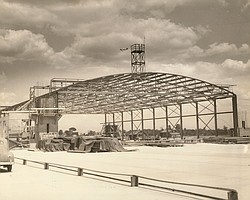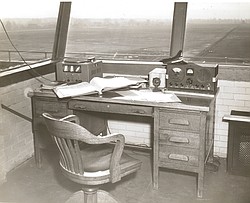76 years later, YW Regional faces new challenges
By KALEA HALL
khall@vindy.com
VIENNA
VIDEO: History of Youngstown-Warren Regional Airport
History of Youngstown-Warren Regional Airport

Look back at the history of the Youngstown-Warren Regional Airport.
Viable in Vienna

When a stretch of land in Vienna Township was transformed into a taxiway, tarmac and terminal 76 years ago, it was the talk of the town.
“Youngstown will be a next-door neighbor to virtually all American cities with the inauguration of air service at the new airport,” reads a special Vindicator airport edition on June 29, 1941.
Service kicked off on July 1, 1941, but the airport’s purpose wasn’t just for passengers. The other goal was faster delivery of the Valley’s mail.
“The air service will be a particularly big boom to Youngstown Sheet and Tube in rushing mail confirmations of orders from various district offices or in submitting bids on important contracts,” The Vindicator story reads.
Life at the airport today is a bit different. There’s no longer daily flight service to business destinations such as New York and Chicago and air mail service is no more.
Allegiant Air is the only commercial airliner in operation at the local airport. The Las Vegas-based airline offers three leisure destinations.
Allegiant came to the Youngstown airport in 2006 with service to Sanford/Orlando, Fla. In 2011, Myrtle Beach, S.C., and St. Petersburg, Fla., flights were added. In 2013, the local airport received its fourth Allegiant flight to Fort Myers, Fla.
But Fort Myers is currently on an extended hiatus and an Allegiant spokesman says there’s no definitive date set for the return of that service.
Last year, for the first time since 2008, the airport saw a decline in the amount of year-over-year passengers.
Since then, Allegiant has spread it wings to include service to Youngstown’s closest competitors: airports in Akron, Cleveland and Pittsburgh.
The inclusion of Allegiant and other low-cost carriers at nearby airports has “absolutely” affected local travel, says Dan Dickten, director of aviation at the airport.
Allegiant started service at the Pittsburgh International Airport in 2014 and today offers 10 destinations from Pittsburgh. Allegiant left Akron-Canton Airport and added service to Cleveland this year. Allegiant offers 11 destinations out of Cleveland.
“Competition is fierce,” Dickten said, “... an airport is a very big economic generator.”
Dickten continually meets with airlines at conferences and shows off what Youngstown has to offer to encourage them to consider starting up service in Youngstown.
“It’s like speed dating,” Dickten said of the numerous, short meetings.
The goal is to see the Allegiant service grow, to have a daily service and to see the airport become self sufficient without the help of the Western Reserve Port Authority, which oversees the airport and provides funding through hotel bed tax revenues. In 2016, of the about $1.4 million in hotel bed tax allocated to the port authority, about $1.25 million was received by the airport.
The airport gets revenue from landing fees, hangar and property lease rent, operating fees from aviation businesses on the airport, fees from aviation fuel sale on the airport, airline facilities usage fees and concessions fees which includes parking lot fees.
TIME TO FLY
It was summer 1941 when flights began from Vienna, but it was no easy task.
It was “a long, hard knock-em-down-and-drag-em-out battle,” according to The Vindicator files.
Youngstown was the second Ohio city to have an airport and get direct air service with the Lansdowne Airport on the East Side, but that airport quickly became outdated.
“Night flights passed up Youngstown entirely; and so did the day plans when the weather was bad or the field was soft, or the loads were unusually heavy – until the service was abandoned in 1930,” The Vindicator printed.
In 1933, Fred L. Smith, state director of aeronautics and state administrator of a $5 million fund to improve and build Ohio airports, happened to deplore the lack of an adequate airport service in Youngstown.
“Smith made repeated trips to Youngstown, trying to get the city to select a site and build an airport, but the city dilly-dallied, council declined to act – and finally the money went elsewhere,” files read.
In the mid 1930s, the chambers of commerce of Warren, Youngstown, Niles, Hubbard and Sharon, Pa., decided to make the airport project a community effort. In January 1937, a committee that included William F. Maag Jr., then-publisher of The Vindicator, went to Washington to secure Works Progress Administration funds. Eventually, Youngstown took over the whole $2.6 million WPA project. Land for the airport was obtained with the help of Maag and construction began in June 1939. Once again it appeared Youngstown would be back on top of aviation in the state. The campaign began to receive government approval for Pennsylvania Central Airlines and United to start service in Youngstown.
In March 1941, Pennsylvania Central and United were granted authority to stop at Youngstown airport, placing Youngstown on United’s main transcontinental route from New York to Oakland, Calif. and Pennsylvania Central’s from Norfolk to Detroit.
The special section of The Vindicator’s Sunday, June 29, 1941, edition reflects the airport’s deep community support. The pages are filled with advertisements congratulating the airport. Strouss-
Hirshberg’s offered flight fashions; Lustig’s, a popular downtown shoe store, announced its pride in having a new airport like many other downtown businesses, including Livingston’s.
“It was a big step up and these people were looking up to the future,” said Bill Lawson, Mahoning Valley Historical Society executive director. “It was convenient. At that point it wasn’t easy to drive to Cleveland, Pittsburgh and Akron.”
Vindicator files show the airport thriving throughout the 1940s. In 1949, 42,000 passengers used commercial air service at the Youngstown Municipal Airport.
Bob Mann, an aviation industry analyst, explained that in the 1940s air travel was really only done by business people and government officials. Families still relied on the family car or buses for vacations. After the industry was deregulated in the late 1970s, flights were cheaper.
“The market expanded dramatically,” Mann said.
In 1951, the Air Force sought $3.11 million in federal funds for land at the Vienna airport. In May 1951, $7 million was received to build a jet base. The city signed a 25-year contract for the base on airport land. The airport was crucial to having the air base here, Lawson said.
“We do a lot of things in a collaborative manor,” Dickten said. “We are looking at doing more and more together.”
In the early 1990s, then-Youngstown Mayor Pat Ungaro said he would close the airport unless there was a solution found for the city’s financial problems. The Youngstown and Warren chambers of commerce pushed for a regional airport owned by the two counties – thus came the creation of the Western Reserve Port Authority. In 1992, the name of the airport was changed to the Youngstown/Warren Regional Airport.
MOVING FORWARD
In 1998, the airport had three daily network carriers: United, Northwest and USAir. By 2002, all three were gone. Allegiant arrived at the airport in 2006 and offered its southern destinations.
Between 2009 and 2010, the airport saw a 51 percent increase in the number of passengers that came through the terminal with 35,087 passengers in 2009 to 52,526 in 2010. From 2011 to 2012, the number of passengers increased again by 34 percent, and again the next year by 10 percent. By 2015, the airport saw 133,927 passengers. Last year was the first year since 2008 that the airport saw a decline in passengers with a total of 109,287.
“I think we will have a comparable year this year,” Dickten said.
Last year was supposed to be the grand comeback of daily service at the airport.
The Great Lakes JetExpress operated by Aerodynamics Inc., a charter service company, launched on July 1 with daily flights to Chicago O’Hare International Airport and landed its last flight Aug. 24 because of low ticket sales. The flights were grounded after the WRPA board pulled the subsidy it provided ADI to run the daily service. The board believed the airline had an interline agreement with United Airways, but it did not, making it difficult for those who wanted to connect to United from a Great Lakes flight.
The airport used its $1.2 million revenue guarantee to subsidize the service. Of that, $780,000 was awarded by the Department of Transportations several years ago to help the airport attract daily air service. The other $420,000 is hotel-motel lodging tax money that comes into the port authority. Dickten said the airport has about half of the $1.2 million left to use for service, and it has received an extension on the DOT grant.
TRYING TO TAKE OFF
Smaller airports took a hit this year when President Donald J. Trump’s budget announced the end of the Essential Air Service program, which gives small towns and communities access to air service. The Youngstown/Warren Regional Airport is not eligible for EAS because of the 70-mile rule that states any airports operating within 70 miles of a large hub airport are not eligible. Youngstown’s proximity to the Pittsburgh airport led to the loss of EAS funding in 2003.
To help market the airport, the port authority hired Tom Reich in 2010. Reich is the director of service development for AVPorts, a consulting service for airports. Reich is paid a retainer of about $3,500 a month.
When Dickten meets with airlines, he shows them the population of about 800,000, the local airport services, the success of Allegiant’s service and why travelers choose to fly through Youngstown.
“We talk a lot about the local economy,” Dickten said. “Over the last six years it has had a rebound.”
Most passengers live within 30 minutes of the airport, which makes it convenient for them.
But most airlines don’t see drive time to Pittsburgh or Cleveland as much of an inconvenience for travelers.
“They look at any drive time as one hour and a half as reasonable,” Reich said.
Last fall, airport officials met with United Airlines to try and get service to Chicago O’Hare. United ended up selecting other airports connected to large universities.
At the Routes Americas conference in Las Vegas in February, Dickten met with six airlines. Later this month, Dickten will attend the Allegiant conference and in June he will attend the JumpStart Air Service Development Conference in Rhode Island.
“It’s going to be a tough sell,” Mann said of getting more service to smaller airports.
There’s a shortage of pilots and crew members leading airlines to scrutinize where they place service.
“The objective on the part of the carriers is to place the crew and the aircraft they have in the markets with the best results,” Mann said.
So, even if an airline can make money at an airport it still wants to be where it can make the most money.
“At the end of the day it is a carriers’ market, not an airports’ market,” Mann said. “There’s just so many opportunities for these airlines.”
 43
43
